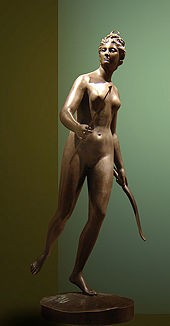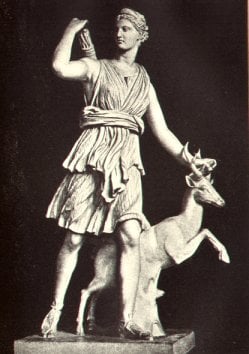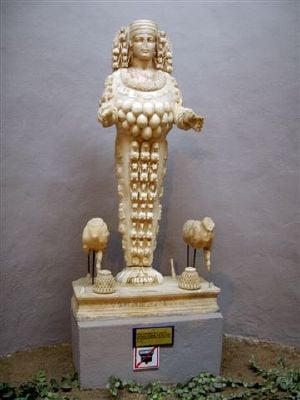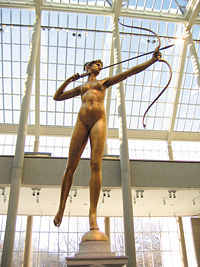Diana (mythology)
In Roman mythology, Diana was the goddess of the hunt, in literature the equivalent of the Greek goddess Artemis. The daughter of Zeus and Latona, Diana was born with her twin brother Apollo on the island of Delos.
A goddess of both chastity and fertility, and later of the moon, Diana's cult became popular throughout the ancient Roman empire, both among the nobility and the lower classes. She was the patron of slaves, who could find sanctuary in he temples, and of women seeking to conceive healthy children. Eternally young and beautiful, she was known to be quick to anger and fiercely defended her virginity against male assaults, both subtle and direct.
Often portrayed with bow and arrow and accompanied either by a deer or hounds, Diana was both the goddess of the hunt and of domestic animals. Her temple in Ephesus was one of the wonders of the world, being rebuilt several times until it was destroyed by a Christian mob in the early fifth century CE.
As the goddess of the hunt, Diana figured in later European myths of the female Wild Hunt. During the Renaissance, she became a popular figure in art, poetry, and drama. More recently, her early role both as strong female deity has been examined in academic discussions of the history of religions, and she has inspired a branch of the neo-pagan religion.
Goddess of the hunt
Diana was the virgin hunting goddess, associated with wild animals and woodlands. She also later became a moon goddess, supplanting Luna, and was an emblem of chastity. Oak groves were especially sacred to her. She was praised in poetry for her strength, athletic grace, purity, distinct beauty, and hunting skill.
Etymologically, "Diana" means simply "the Goddess," parallel to the name of Greek goddess Dione at Dodona, although the two are not related either mythologically of in terms of cult practice. She was goddess of fertility worshiped especially by women seeking seeking conception and healthy delivery. Diana was regarded with great reverence by lower-class citizens and slaves, and runaway slaves could receive asylum in her temples.
Diana was also a goddess of domestic animals. As the goddess of the hunt, she may have evolved from an earlier forest deity. Diana also made up a trinity with two other Roman deities: Egeria the water nymph, who was her servant and assistant midwife; and Virbius, the woodland god.
Diana was worshiped at a festival on August 13, the date upon which King Servius Tullius dedicated her shrine on the Aventine Hill in Rome in the mid-sixth century B.C.E. Being placed on the Aventine, and thus outside the of Rome's sacred boundaries, meant that Diana's cult essentially remained a "foreign" one at this time, like that of Bacchus (Dionysus). Diana remained in this position and was never officially transferred to Rome as was the case with some other deities. It seems that her cult originated in town of Aricia near Rome, where her priest, the Rex Nemorensis ("the king of the grove") remained, by the shores of Lake Nemi. There the simple open-air temple was held in common by the Latin tribes, and legend holds that a new priest replace his predecessor only by slaying him.

Diana is sometimes portrayed as accompanied by a deer, such as in the Diana of Versailles, as the patroness of hunting. The deer may also be a reference to the myth of Acteon (or Actaeon), who saw Diana bathing naked, whereupon Diana transformed him into a stag and set his own hunting dogs to kill him. Some Roman patrons ordered marble replicas of the Anatolian version of "Diana of Ephesus," as the goddess of domestic animals. However, Diana was usually depicted by the Romans in her Greek guise.
Worship of Diana is also mentioned in the Bible. In Acts of the Apostles, Ephesian metalsmiths who felt threatened by Saint Paul’s preaching of Christianity, jealously rioted in Diana's defense, shouting “Great is Diana of the Ephesians!” (Acts 19:28, New English Bible). Her temple at Ephesus was one of the Seven Wonders of the World and was ultimately destroyed by a Christian mob led by Saint John Chrysostom in the (number) century.
Legacy
Diana's worship may be related in Early Modern Europe to the cult of the Scottish goddessNicevenn (aka Dame Habond, Perchta, Herodiana). She has also been connected to myths of a female Wild Hunt. Female members of the sect known as the Benandanti ("Good Walkers"), in their struggles against evil witches during the sixteenth and seventeenth centuries, believed that they left their bodies during the night and communed with Diana or a similar goddess in defeating witchcraft.
Both the Romanian word for "fairy," zânǎ and the Asturian word for "water nymph," xana, may be related to the name of Diana.
In Italy, the old religion of Stregheria embraced Diana as Queen of the (good) Witches, who were wise women and healers. According to Stregheria myths, Diana was the Mother Goddess who created the world out of her own being, having in herself the seeds of all creation yet to come.
Since the Renaissance, the mythic Diana has often been expressed in the visual and dramatic arts, including the opera L'arbore di Diana. In the sixteenth century, Diana's image figured prominently at the Château de Fontainebleau, in deference to Diane de Poitiers, mistress of two French kings. At Versailles she was incorporated into the Olympian iconography with which Louis XIV, the Apollo-like "Sun King" liked to surround himself.
There are also references to Diana in popular literature. In Shakespeare's play, Romeo and Juliet, with its theme of the tension between chastity and romance, contains many references to Diana. Diana is also a character in the 1876 Leo Delibe ballet Sylvia. The plot deals one of Diana's nymphs who is sworn to chastity, featuring Diana's assault on Sylvia's affections for the shepherd Amyntas.
In Jean Cocteau's 1946 film La Belle et la Bête it is Diana's power which has transformed and imprisoned the beast.
Modern day
Diana remains an important figure in some modern thought. Feminist writers sometimes portray Diana as having originated in a mother goddess worshiped in prehistoric times when societies were organized along lived in matriarchal lines.
A branch of neo-paganism known as Dianic Wicca is named for her, characterized by an exclusive focus on the feminine aspect of the Divine.
In comic book lore, the character of Wonder Woman is rich in Greek mythology in which the main character is a descendant of the gods, whose alter ego is named Diana Prince.
See also
- Diana Nemorensis
- Wild Hunt
External links
| |||||
Notes
See also
- Diana Nemorensis
- Wild Hunt
External links
| |||||
Credits
New World Encyclopedia writers and editors rewrote and completed the Wikipedia article in accordance with New World Encyclopedia standards. This article abides by terms of the Creative Commons CC-by-sa 3.0 License (CC-by-sa), which may be used and disseminated with proper attribution. Credit is due under the terms of this license that can reference both the New World Encyclopedia contributors and the selfless volunteer contributors of the Wikimedia Foundation. To cite this article click here for a list of acceptable citing formats.The history of earlier contributions by wikipedians is accessible to researchers here:
The history of this article since it was imported to New World Encyclopedia:
Note: Some restrictions may apply to use of individual images which are separately licensed.



